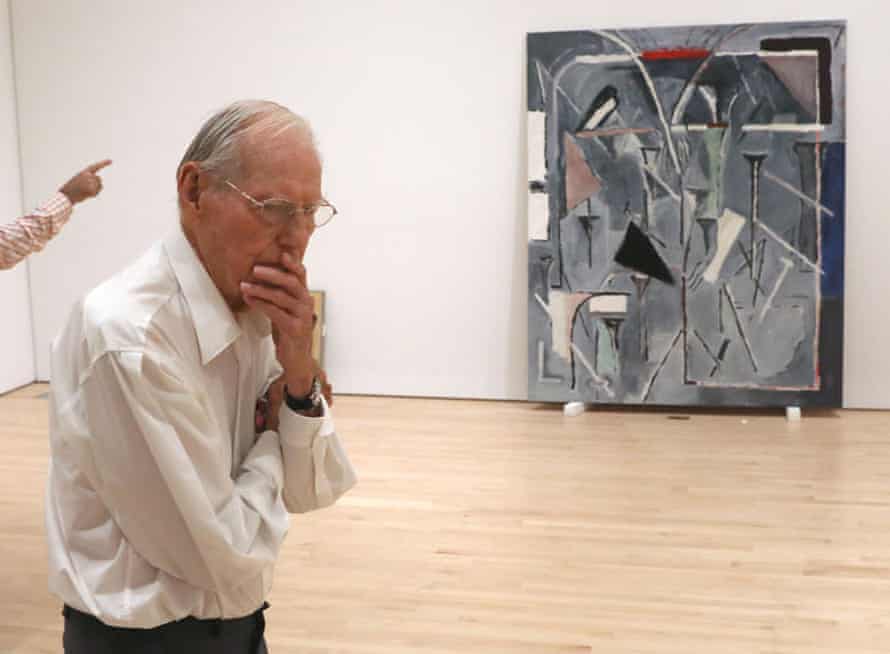The American artist Wayne Thiebaud, whose luscious, colorful paintings of cakes and San Francisco cityscapes combined sensuousness, nostalgia and a hint of melancholy, has died. He was 101.
His death was confirmed in a statement on Sunday by his gallery, Acquavella, which did not say where or when he died.
“Even at 101 years old, he still spent most days in the studio, driven by, as he described with his characteristic humility, ‘this almost neurotic fixation of trying to learn to paint’,” the statement said.
Thiebaud was born in Mesa, Arizona, in 1920 and grew up in Sacramento, California. He started out as an animator for Walt Disney and worked as a poster designer and commercial artist in California and New York before becoming a painter. He also was a longtime professor at the University of California, Davis. He retired in 1991 but continued teaching one class a year.
While some took his hot dogs, bakery counters, gum ball machines and candy apples to be examples of pop art, Thiebaud never considered himself to be in the mold of Andy Warhol and did not treat his subjects with the irony pop championed.
“Of course, you’re thankful when anyone ever calls you anything,” he said. “But I never felt much a part of it. I must say I never really liked pop art very much.”
The real subject, many critics said, was paint and the act of painting itself: the shimmering color and sensuous texture of thickly applied paint. He laid on paint so heavily that he often carved his signature instead of putting it on with the brush.
“The oil paint is made to look like meringue,” said Marla Prather, a curator at the Whitney Museum of American Art in New York who helped organize a 2001 retrospective. “And with the cakes, you get this great sense of texture with the frosting. You just want to step close and lick it.”
Many of Thiebaud’s images were outlined in neon pinks and blues that made the objects appear to glow. Shadows were often a rich blue.
“It’s joyful, while a lot of modern art is angst-ridden,” Prather said in 2001.
Thiebaud told PBS’ NewsHour with Jim Lehrer in 2000 the subject of food was “fun and humorous, and that’s dangerous in the art world, I think.
“It’s a world that takes itself very seriously, and of course, it is a serious enterprise, but I think also there’s room for wit and humor because humor gives us, I think, a sense of perspective.”
Gum ball machines were a favorite theme, he said, because “a big round globe is so beautiful, and it’s really a kind of orchestration of circles of all kinds. But it’s also very sensuous, I think, and it offers wonderful opportunities for painting something like, almost like a bouquet of flowers.”
In 2004, a New York Times writer praised Thiebaud’s “wry vision of modern consumerism” and said: “No one did more to reanimate the tired old genre of still life painting in the last half century than did Mr Thiebaud with his paintings of industrially regimented food products.”

Thiebaud told PBS he preferred calling himself a painter, rather than an artist, because “it’s like a priest referring to himself as a saint. Maybe it’s a little too early or he’s not the one to decide that … Being an artist I think is a very rare thing.”
Along with the sensuousness, there was sometimes an emptiness and melancholy reminiscent of Edward Hopper. He likened the feeling to the “bright pathos” of a circus clown.
In landscape, his most famous subject was San Francisco, whose steep hills he portrayed in a fantasy like way, with spectacular angles and stark shadows.
“Originally, I painted right on the streets, trying to get some of the kind of drama I felt about the city and its vertiginous (dizzying) character,” he told PBS.
“But that didn’t seem to work … The reality was one thing but the fantasy or the exploration of it was another.”